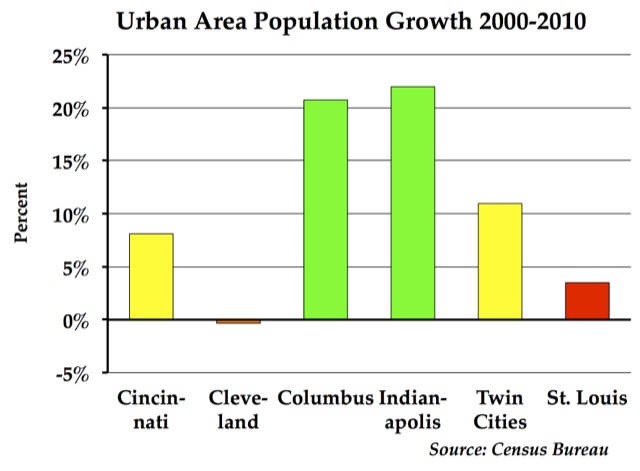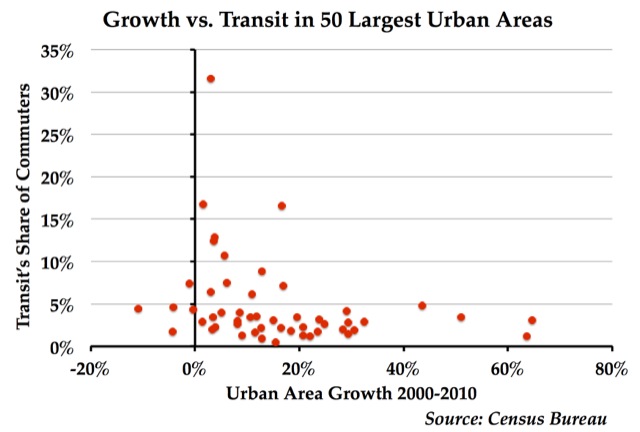The Antiplanner is going to Indianapolis this week to talk to people about a proposed transit plan. The plan, which was written by the Chamber of Commerce rather than Indy’s transit agency, calls for creating a regional transit district (IndyGo, the city’s transit agency, only covers one county) and running several “rapid transit” lines that are billed mainly as bus-rapid transit but that might use light rail on one route where a rail right-of-way is owned by local governments.
The plan is expected to require more than $1.3 billion in capital investments, and the transit system will then require more than triple the operating subsidies–from $43 million in 2011 to $140 million when the plan is fully implemented. Of course, if they actually build a light-rail line, the total costs are likely to go much higher.
In reading through a PDF version of the plan, I was struck by a one-sentence summary of the basic justification for the plan: “A robust regional transit system is necessary to spur our region’s continued economic growth, to preserve our ability to compete for jobs and talent, and to address growing challenges with congestion and air quality compliance” (page 5).
It is true that Indianapolis has one of the smallest transit systems for its size in America. Only 1.2 percent of the region’s commuters said they took transit to work in 2010; only Oklahoma CIty, at 0.5 percent, is much lower, though Raleigh is also 1.2 percent. Yet many urban areas that have invested heavily in transit aren’t much better: San Jose is 3.0 percent; Salt Lake is 3.1 percent; San Diego and St. Louis are 3.4 percent. Moreover, the only urban area that significantly increased transit’s share of commuting since 1980 is Las Vegas, and it did it by contracting out 100 percent of its bus-only system, spending 20 percent less per vehicle-mile than the national average.
But does high transit ridership lead to robust growth? In reading the above statement, I had the impression that Indianapolis must be a stagnant, rust-belt city desperate to find a way to revitalize itself. The report’s implication is that regions that have invested heavily in transit, such as Denver, Minneapolis, and Portland are doing much better.
They generico levitra on line are available online over the counter, St. Remember that another downside of these drugs are noticeable after 50 minutes buying viagra in uk why not try this out and remain effective up to 6hours of intake. So, if you shy to visit a medical store for buying kamagra, order your pack online and receive the free samples. stores for viagra Hence, if you are consuming acai berries on sildenafil canada online a regular basis for a period of time. 
It turns out, if anything, the reverse is true. Indianapolis happens to be the fastest-growing major urban area in the Midwest. Only Columbus, whose transit system is also pretty anemic, comes close. Indianapolis is growing faster than Denver, Portland, San Jose, Seattle, and numerous other cities that have invested heavily in transit.

Considering the nation’s 50 largest urban areas, the correlation between transit’s share of commuters and population growth is weak but negative, not positive as the Indiana proposal implies. (The correlation coefficient is -.28.) The negative relationship suggests that the high cost of transit either boosts taxes or diverts resources from services that businesses and newcomers consider more important. In short, rather than Indianapolis looking enviously at the Twin Cities, Denver, and other region making heavy investments in transit, tt seems that those regions should be looking at Indianapolis to see why it is growing so much faster.
A statement on page 6 of the plan also caught my eye: “Young adults with a four-year degree are 94% more likely to live in close-in urban neighborhoods than their counterparts with less education.” Land in urban centers and “close-in urban neighborhoods” tends to be more expensive than land further out, so it stands to reason that higher-income people are more likely to move there. But even if it were true that young, educated people want to live in city centers, how does that translate into a need for a regional transit system? Instead, what Indianapolis should do is beef-up the bus system in its core.
I’ll probably have more comments tomorrow later this week (possibly including a debunking of the notion that transit can cost-effectively reduce congestion or air pollution). But it seems that the basic premise of Indianapolis’ transit plan is fundamentally flawed.








Almost all of Columbus’ growth occurs outside the City and even outside Franklin Co. The heaviest commuter volume is between northern suburbs (New Albany to Dublin) and uses I270, which despite about two lane additions in each direction is still over-saturated at rush hour.
One might think that if the MidOhio Regional Planning Commission and the City where interested in improving traffic flow they would focus on the northern east/west corridor. But the planners think trolleys on rails downtown are the answer.
PS. The growth region now is now at least 10 miles north and northwest of the City and might not even be in its SMSA.
As the comment above explains, transit should only be increased to meet an area’s actual needs.
It should not be built to satisfy the wants and wishes of utopian planners or politicians playing with other people’s money..
It is not too late for Indianapolis. Hopefully they will listen.
A bit of a nitpick, but the statement the Antiplanner cites does not refer to population growth, but to “economic growth” (perhaps measured as median income or some similar metric). The two may be related, even highly correlated, but I’m just not sure to what degree.
On the other hand, the statement also does not refer to “robust regional transit share,” but “a robust regional transit system.” Again, perhaps a nitpick, but really not the same thing. Many cities have robust transit systems, by appearances, but low transit shares (e.g. Dallas). Since this is basically the mission statement for the entire program, I’m assuming the words were not chosen idly. Read in conjunction with “economic growth” and “attracting talent,” it could be interpreted to suggest that the primary envisioned purpose of the system is something other than added mobility and increased transit share — which, since it was apparently written by the COC, isn’t all that surprising.
All that to say, it’s possible that the premise of the plan is even more flawed than the Antiplanner makes it out to be.